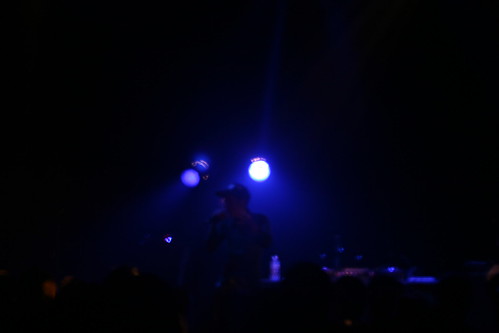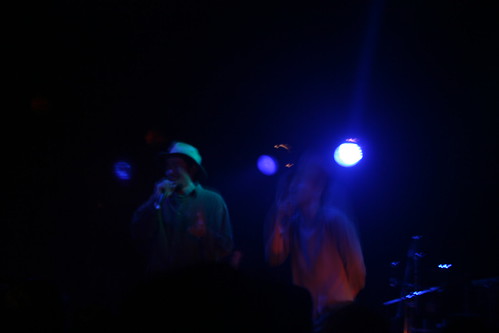Thanks to a mix of language barriers and cultural stereotypes, most ‘heads think Japanese hip-hop is derivative, silly, or downright racist. But the emerging Japanese underground is pumping out excellent, innovative tracks that deserve to be heard around the world. Japan The Beats highlights the best of these releases and tells the stories behind them.
Well, it’s been a while. Writing Japan the Beats from 2008-09 gave way to some more serious business through the end of 2009 and much of last year — but we’re back on the air and hopefully in an improved form. Particularly, I’ll be working to point you to, at the least, samples of the music I talk about here. That’s what it’s really about, after all, and it’s easy to forget some of the barriers that exist to finding it, even in this age of digital omni-access.
So we begin again, and how better to return than with a repetition. I spent late last year at a concert featuring Origami, the group that first got me interested in Japanese hip-hop. On my way there, I spent the afternoon in Nakameguro, one of the wealthiest areas of Tokyo. Nakameguro has a reputation for being very “European,” from its tree-lined avenues and quiet cafes to its extremely upscale boutiques. The best Japanese clothing stores are small wonders. Many of them mix new products with used, assembling objects from around the globe with such careful curation they are essentially museums (especially at these prices — be careful what you touch).
I have to admit a weakness for a particular streak of English countryside-chic that has been huge in Tokyo for many years — lots of loose-knit cottons, collarless peasant shirts and a dozen shades of brown and grey. A lot of it would be summed up with that immortal Wire line — tweedy impertinence. Olgou represents this style refined to a beautiful sheen — I found a leather shoulder bag, dating maybe to the 1930s, whose handle was made from an actual antler, and the fact that they were selling jodphurs somehow didn’t seem totally absurd. I bought a $40 scarf, just to honor the purity of vision.
That’s also about what it cost me to get into UNIT to see this show — 3800 yen plus a mandatory 700-yen drink. As I may have mentioned at one point, the nightclub business in Japan tends to depend on much higher door charges. They probably weren’t selling much beer to this crowd anyway, based on the cardigan sweaters, black frames, suspenders, and fedoras; the audience seemed to have come straight from Olgou, grandpa style and quiet mannerisms paid in full. I saw exactly one guy in a t-shirt and dreadlocks — this wouldn’t have been recognized even as a nerdy indie-rap crowd in the US.
Tamaki Roy played first, after being introduced by Take (Ta-kay) and MC Atom from Suika, who were hosting the show and promoting their forthcoming album. Roy did his own basic DJing, along with in-depth introductions to songs that began to connect the long series of dots between South Bronx 1977 and Nerdy Tokyo 2010. The beats were huge, loud, crisply produced, and somehow soaking in melancholy. Songs like “Rokunenkan [Six Years],” a funky electro banger looking back over childhood. The room held 200 people, but felt extremely intimate, as Roy described the feelings and motivations — usually, more specifically, the worries — that led him to make each song.
Hip-hop has always had a deep nostalgic streak — personally, I think of Wu-Tang’s “Can It Be All So Simple,” with its long intro about “the good old days.” But in Japan, nostalgia is something of an art form, expressed in everything from fashion trends that imagine web designers as hip tenant farmers to cafes that reproduce French patisseries down to the flaking paint on a window frame. To be more precise, the Japanese term for this emotional drive is natsukashisa, and it is different from nostalgia primarily because everyone accepts that natsukashii can have no object, can be a pure appreciation for the impermanence of life.
Just like Ougou is the height of nostalgia in Japanese fashion, Origami may represent the highest development of it in Japanese hip-hop, and this show, like most of theirs, was deeply reflective and melancholy. After a typically hype introduction, there was a strange silence and darkness on stage, as if there were some sort of problem. But then Shibito emerged, slowly, to take the microphone. With a tent-like brown Pendleton buttoned up to his neck and a hat that looked to have been dunked in a dozen mountain streams, he matched his audience, which waited in total silence.
Without prelude, he launched into what has become Origami’s signature innovation — a long, written vocal riff mixing clever wordplay and quick transitions to mournful snippets of song. This is almost closer to theater than rap, telling stories and, especially when Shibito is joined by his partner Nanorunamonai, little sketches of social interaction. Tonight, Nanorunamonai emerged and they traded observations about the clouds — appreciation for nature, especially ephemeral elements like clouds and cherry blossoms, is a huge element of natsukashisa. Origami have apparently been careful to limit their work’s online availability, but you can see one good example of their live show here.
Suika (which means “watermelon”) took the stage last, and finally the mood of contemplative natsukashisa was broken. They’re three MCs backed by a live band, dominated by a Hammond organ whose bright, clean sound puts them in the realm of Umphrey’s McGee or Medeski, Martin, & Wood. The one interesting element, to me, is MC Toto, a woman whose style would be totally alien to America. American female rappers have to be either hyper-sexual or hyper-aggressive, usually both. Toto gets away with sounding pretty much like a little girl, and last night at Unit she was wearing a flowing sun dress that further defined her as lighthearted and playful. This sort of persona is representative of a certain stream of female Japanese rappers, and it does open up some interesting creative space — Toto has appeared to great effect on Origami records and has her own evocative take on the freestyle/soliloquy. But it also, of course, taps into and reinforces lingering gender inequality in Japan, perpetuating the idea of women as fundamentally childlike.
The night ended with Suika welcoming a series of guests onto the stage for long cyphers, though this had none of the competitive aggression that defines such moments in American concerts; instead, it had the feel of old friends comfortably trading stories. In addition to bringing back Origami and Tamaki Roy, Suika were joined by Romancrew for an encore before ending the show. By this time, I was mostly preoccupied talking to Origami’s DJ, KOR-one, about his recent experiments with distortion pedals, and with their frequent producer, Yamaan, about his upcoming solo album. Watch this space for more information about both projects, or check for them yourself at the Temple-ATS website. You can also check out occasional smaller bits on Japanese hip-hop and Japanese culture and politics at my blog, Minds Like Knives.



